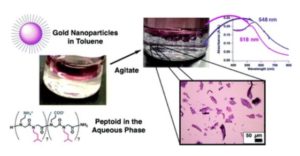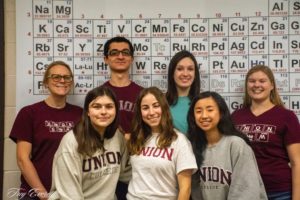We are pleased to let you know that Ellen Robertson has reached a ChemComm Milestone with her #ChemComm1st article: ‘Synthesis and characterization of plasmonic peptoid nanosheets‘.
Find out about Ellen and her research below.
What are the main areas of research in your lab and what motivated you to take this direction?
I’m a physical chemist by training and my research specifically focuses on colloid and interfacial science. In my lab, we are working to develop new classes of surface enhanced Raman scattering sensors based on the co-assembly of two-dimensional peptoid scaffolds and nanoparticles at fluid surfaces. Our goal is to use these sensors to detect environmental pollutants that are prevalent in Upstate New York. I’ve always been interested in using chemistry to solve environmental problems. In college, I worked on a service-learning project in my introductory chemistry course in which we collected soil and water samples from the community and tested them for lead. I realized from this example how chemistry can be used for the good of the environment and its inhabitants, and it is my aim as a chemist to do this kind of good.
Can you set this article in a wider context?
The research presented in this article clearly demonstrates how the power of interfacial self-assembly can be implemented to fabricate new nanomaterials with interesting properties. I believe the method described in the paper for forming plasmonic peptoid nanosheets can likely be extended to creating two-dimensional arrays of magnetic, semiconducting, antibacterial, and catalytic nanoparticles. This generalizable strategy has the potential for creating a new class of two-dimensional nanomaterials that have a wide range of optical, electronic, and magnetic properties.
What do you hope your lab can achieve in the coming year?
In the upcoming year, my lab hopes to test the limits of our peptoid-directed assembly mechanism for forming new two-dimensional nanomaterials. We are planning to see if we can fine-tune the properties of these nanosheets by varying the nanoparticle concentration, size, surface chemistry, and material used in the synthesis.
Describe your journey to becoming an independent researcher.
My journey to becoming an independent researcher was the result of my love of chemistry and some timely opportunities that I was able to pursue. I started my research path as an undergraduate at Kalamazoo College. I worked in Jeff Bartz’s lab studying the gas phase dissociation of NOx compounds. Jeff encouraged me to pursue summer research opportunities, and I was grateful to have the opportunity to work for one summer at Dartmouth College making cobalt nanoparticles in Barney Grubb’s lab, and one summer at the University of Oregon studying interfacial assembly in Geraldine Richmond’s lab. I loved the Richmond lab research so much, I returned as a graduate student to complete my Ph.D. research, which focused on understanding the assembly of polyelectrolytes at the oil-water interface using vibrational sum frequency spectroscopy (VSFS) and interfacial tension measurements. While in graduate school, I worked on collaborative project between Geri’s lab and Ron Zuckermann’s lab at Lawrence Berkeley National Lab in which I characterized peptoid monolayers using VSFS. The aim of these studies was to assign spectroscopic signatures to peptoid monolayers that were capable of forming peptoid nanosheets via monolayer compression and collapse. Working on this collaboration was a great experience and prompted me to apply for and accept a postdoctoral position in Ron’s lab. I spent two years working in Ron’s lab using interfacial tension and rheology to determine the factors that affect the ability of different peptoid sequences to form monolayers capable of collapse into nanosheets. Following my postdoctoral appointment, I returned to Kalamazoo College as a Visiting Assistant Professor of Chemistry. It was here that I realized my love of working with undergraduates in the research lab, and so I sought out a position at a primarily undergraduate institution. Now an Assistant Professor of Chemistry at Union College, my independent research combines elements of my graduate research (self-assembly at the oil-water interface) with my post-doctoral research (using peptoids to create new materials).
What is the best piece of advice you have ever been given?
Some of the best advice that I have ever been given is to embrace a growth mindset. With a growth mindset, we can always envision new ways to improve, both professionally and personally. Failure no longer becomes an obstacle, but an opportunity to learn something new and grow.
Why did you choose to publish in ChemComm?
I chose to publish in ChemComm because this journal is well known for publishing novel research that is of immediate and broad interest to those in the field of chemistry. I was so excited when my lab discovered the plasmonic peptoid nanosheets described in our recent ChemComm publication. I realized that the synthesis of these novel materials through peptoid monolayer collapse at the oil-water interface opened the door for creating a brand-new class of two-dimensional nanomaterials. I wanted to share this discovery with a broad audience of chemists that could see the utility in these new materials and the method used to prepare them. I am grateful for the opportunity that ChemComm has given me to share my science story.
Back: Ellen Robertson, Chris Avanessian, Anna Mahony, Elizabeth Whitney
Front: Misty Zaczyk, Mindle Shavy Paneth, Jana Davis
Professor Ellen J. Robertson received her Ph.D. in physical chemistry at the University of Oregon where she studied the assembly of polyelectrolytes at the oil-water interface using vibrational sum frequency spectroscopy. Ellen then held a post-doctoral appointment at Lawrence Berkeley National Lab where she studied the assembly mechanism of peptoid nanosheets at the air-water interface. After serving as a Visiting Assistant Professor of Chemistry at Kalamazoo College for two years, Ellen was hired as an Assistant Professor of Chemistry at Union College, a small private liberal arts institution in Upstate New York. Here, she has established her research program, the overall goal of which is to develop peptoid-based surface enhanced Raman scattering sensors for detecting pollutants that are persistent in Upstate New York. Her work has been funded by The Community Foundation for the Greater Capital Region’s Bender Scientific Fund. Ellen is dedicated to undergraduate education in chemistry, both in the classroom and in the research lab. At Union, Ellen teaches courses in general and physical chemistry and works with undergraduates in her research lab. She also co-advises Union College’s American Chemical Society Student Chapter. Outside of chemistry, Ellen is an avid tennis player, competing both at the local and national level.
You can find all of our #ChemComm1st articles in ChemComm Milestones – First Independent Articles. Follow @ChemCommun for all of the latest ChemComm Milestones updates.












